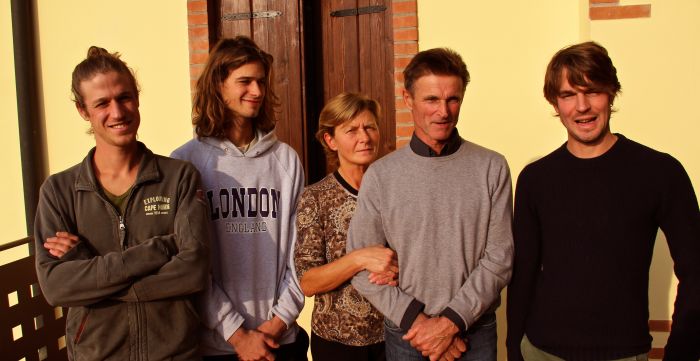
producer profile
29.05.2019
La Biancara Producer Profile
<p>What force of nature brought Angiolino Maule to the vines? On meeting him, you would swear he was born to it, that he breathes it, that the vineyard is deeply a part of his soul. A man of true conviction in <glossary term="Viticulture" title="1103">viticulture</glossary> and viniculture, Angiolino actually started his working life running a pizzeria of some renown in Italy (his wife Rosa behind the oven and Angiolino front of house). But the earth and the vines were calling him all the while. Through his hard work and sterling reputation, Angiolino was able to save enough money to start his winery. He chose <glossary term="Gambellara" title="479">Gambellara</glossary> and, principally, the <glossary term="Garganega" title="482">Garganega</glossary> grape to make his magical music in a glass.</p>
<p><glossary term="Gambellara" title="479">Gambellara</glossary> is ostensibly the extension of the <glossary term="Soave" title="965">Soave</glossary> foothills in <glossary term="Veneto" title="1075">Veneto</glossary> into the adjoining province of <glossary term="Vicenza" title="1087">Vicenza</glossary> where the wine changes its name, but not its general composition. The principal white grape is <glossary term="Garganega" title="482">Garganega</glossary> backed up with small amounts of <span class="zalup"><span><glossary term="Trebbiano/Ugni Blanc" title="1043">Trebbiano</glossary><span>.</span></span></span> These hills are <glossary term="Volcanic" title="1117">volcanic</glossary> in origin, and have rich, dark mineral soils with good amounts of fine <span class="zalup"><span><glossary term="Clay" title="301">clay</glossary><span>.</span></span></span> They are south facing slopes that are protected from the blasts of Alpine northern winds by the southern<span class="zalup"><span> <glossary term="Dolomites" title="399">Dolomites</glossary><span>.</span></span></span> The altitude here is between 150 to 250 meters.<br />
<br />
Angiolino’s<span class="zalup"><span> <glossary term="Estate" title="427">estate</glossary><span>,</span></span></span> in the hamlet of Biancara, now covers about 15 <span class="zalup"><span><glossary term="Hectare" title="523">hectares</glossary><span>.</span></span></span> For decades now, he has <glossary term="Plowing" title="810">plowed</glossary> in his vines and not used any soil treatments, <glossary term="Chemicals" title="279">chemical</glossary> or otherwise. Using <glossary term="Biodynamic" title="160">biodynamic</glossary> <glossary term="Viticulture" title="1103">viticultural</glossary> practices, Angiolino has created an organic, living soil and <glossary term="Ecosystem" title="414">ecosystem</glossary> for benefiting the health of the vines and their resistance to any form of malady. He is unwavering in his belief that great wines are the result of healthy, beautiful, <glossary term="Hand Harvesting" title="520">handpicked</glossary> fruit, and the only way to achieve this is through natural processes. <br />
<br />
Furthermore, he believes that the work in the <glossary term="Cellar" title="254">cellar</glossary> -- <span class="zalup"><span><glossary term="Vinification" title="1104">vinification</glossary><span>,</span></span></span> <glossary term="Aging" title="74">aging</glossary> and <glossary term="Bottling" title="185">bottling</glossary> --must be consistent with the work in the vines and involve no additives that compromise the natural fruit material, for better or worse. The <glossary term="Vinification" title="1104">vinifications</glossary> are conducted without <span class="zalup"><span><glossary term="Temperature Control" title="1018">temperature control</glossary><span>,</span></span></span> the addition of <span class="zalup"><span><glossary term="Sulfites" title="993">sulfur</glossary><span>,</span></span></span> <glossary term="Enzymes" title="423">enzymes</glossary> or <glossary term="Commercial Yeast" title="321">yeast</glossary> and without the use of <glossary term="Fining" title="449">fining</glossary> or <span class="zalup"><span><glossary term="Filtration" title="447">filtration</glossary><span>.</span></span></span> <br />
<br />
<em>“The wine is the fruit of the earth transformed by mankind; it is the oldest natural beverage known to us. The quality of a wine is that which is imparted by the vineyard; it is indispensable to return to a </em><glossary term="Viticulture" title="1103"><em>viticulture</em></glossary><em> and viniculture without </em><glossary term="Chemicals" title="279"><em>chemicals</em></glossary><em> in order to make wines that are expressive of their origins, unique and inimitable and that rise above the standardization and homogeneity that defines the majority of wines commercially available today.”</em><br />
-Angiolino Maule.</p>
Article
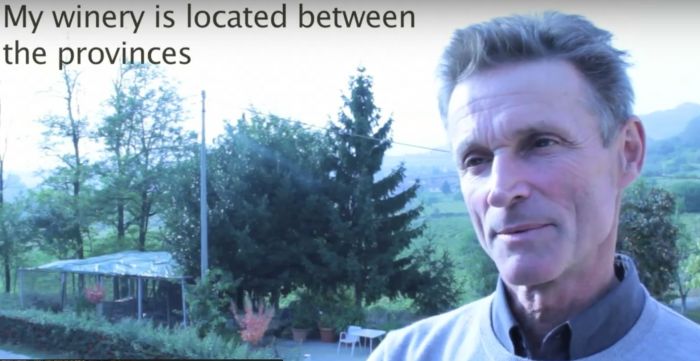
interview
22.05.2019
A Video Interview With Angiolino Maule
<p>Angiolino Maule on his roperty and on his work and research with <em>Vinnatur</em>.</p>
<p><iframe allowfullscreen="" frameborder="0" height="360" src="//www.youtube.com/embed/PjvYYMwWF7o" width="640"></iframe></p>
<p><iframe allowfullscreen="" frameborder="0" height="360" src="//www.youtube.com/embed/MNFX8WRcKG4" width="640"></iframe></p>
Article
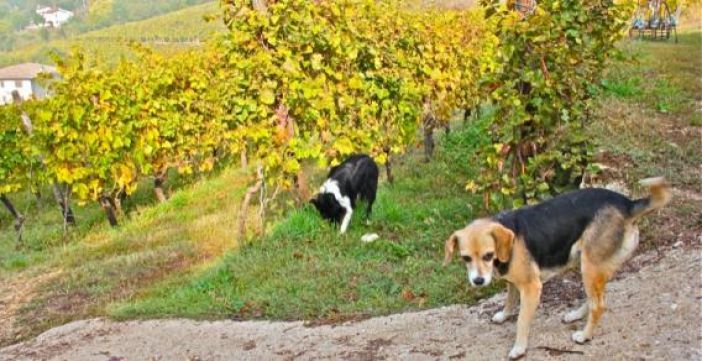
producer visit
17.07.2019
This visit to La Biancara took place in November, 2011
<p><strong><em>This visit at La Biancara took place in November, 2011.</em></strong></p>
<p><strong><em>Words by Jules Dressner, photos by Alex Finberg.</em></strong></p>
<p>When we arrived to la Biancara, we were a little shocked to see one of the Maule dogs hanging out on the roof.<br />
<br />
<img src="http://louisdressner.com/uploads/images/article/2019_Jul_17//a6/e5/a6e5554f349288bb23b3ae72549b6746.jpg" /><br />
<br />
Angiolino was off harvesting his olives, which he uses to make oil for personal consumption, so his son Francesco gave us a tour of the vines.</p>
<p><img src="http://louisdressner.com/uploads/images/article/2019_Jul_17//4e/2a/4e2a45ac36ddfc864e1af8615751b3ef.jpg" /><br />
<br />
With the exception of a few rows, every vine of the <glossary term="Estate" title="427">estate</glossary> has been planted by Angiolino over the years in <glossary term="Guyot" title="518">guyot</glossary> as opposed to <glossary term="Soave" title="965">Soave</glossary>'s traditional <span class="zalup"><span><glossary term="Pergola" title="774">pergola</glossary><span>.</span></span></span> When I asked why, Francesco answered: <em>"quality"</em>. While <glossary term="Pergola" title="774">pergola</glossary> <glossary term="Training System" title="1039">vine training</glossary> is used in hotter climates to protect grapes from the sun, Francesco explained that in the case of <span class="zalup"><span><glossary term="Garganega" title="482">Garganega</glossary><span>,</span></span></span> the main <glossary term="Varietal" title="1071">varietal</glossary> grown at the<span class="zalup"><span> <glossary term="Estate" title="427">estate</glossary><span>,</span></span></span> the grape does not benefit in any way from this type of <span class="zalup"><span><glossary term="Training System" title="1039">vine training</glossary><span>,</span></span></span> and growers hide behind this excuse because <glossary term="Pergola" title="774">pergola</glossary> vines are much more productive, resulting in higher<span class="zalup"><span> <glossary term="Yield" title="1129">yields</glossary><span>.</span></span></span><br />
<br />
<img src="http://louisdressner.com/uploads/images/article/2019_Jul_17//ac/3a/ac3ab6d811cdd3a5b4c8c825fce38061.jpg" /><br />
<br />
For those who don't know, Angiolino is the founder of <span class="zalup"><span><glossary term="Vinnatur" title="1106">Vinnatur</glossary><span>,</span></span></span> the association I consider to be the most forward thinking and progressive dedicated to "<glossary term="Natural WIne" title="708">natural wine</glossary>". <glossary term="Vinnatur" title="1106">Vinnatur</glossary> is more than a group of <glossary term="Vigneron/Vignaiolo" title="1089">vignerons</glossary> working in the same way: it's an institution dedicated to exploration, research and analysis of what goes on in the vineyards -and most importantly in the soil- in order to find reliable and proven methods to work as naturally as possible. Francesco told us their ultimate goal is to eliminate <glossary term="Mildew" title="1137">mildew</glossary> and <glossary term="Oidium" title="737">oidium</glossary> in order to stop using <glossary term="Copper" title="333">copper</glossary> and <glossary term="Sulfites" title="993">sulphur</glossary> <span class="zalup"><span><glossary term="Contact Treatment" title="328">treatments</glossary><span>,</span></span></span> which he and his father feel are the final step to producing 100% <span class="zalup"><span><glossary term="Natural WIne" title="708">natural wines</glossary><span>.</span></span></span><br />
<br />
<img src="http://louisdressner.com/uploads/images/article/2019_Jul_17//6d/2b/6d2b725e5c81dba8dc3db53348bab170.jpg" /><br />
<br />
Francesco showed us a small <glossary term="Plot" title="1133">plot</glossary> of six rows that is funded by <glossary term="Vinnatur" title="1106">Vinnatur</glossary>; in each row a different technique is used (he didn't elaborate further) in order to observe the results and report back to a laboratory in hopes of finding an answer. While they're still searching, one thing is certain: this answer lies in the soil. <br />
<br />
Francesco explained that vines have only suffered from chronic illness like <glossary term="Mildew" title="1137">mildew</glossary> and <glossary term="Oidium" title="737">oidium</glossary> since the beginning of <glossary term="Chemicals" title="279">chemical</glossary> warfare, the very same technology that ultimately led to the creation of all <glossary term="Chemicals" title="279">chemical</glossary> products used in <glossary term="Industrial Agriculture" title="539">industrial agriculture</glossary> today. In just 70 years, the soils have completely shifted in their composition; while Angiolino and <glossary term="Vinnatur" title="1106">Vinnatur</glossary> hope to find out why and rectify this, he acknowledges that even if they do, we have many generations of work ahead of us to bring the soil back to its original state.<br />
<br />
Francesco then showed us their new <glossary term="Cellar" title="254">cellar</glossary> at the very top of a beautiful hill surrounded by the family's vineyards. The installation is completely solar powered, and is much more spacious than the one currently used. They also plan to build a tasting room and a kitchen for parties, and maybe have the top floor converted to a bed and breakfast. 2012 will be the first <glossary term="Vintage" title="1109">vintage</glossary> produced here. <br />
<br />
Well, that's not entirely true, as the Maule's have begun using a specifically designed open air room to hang the grapes that will become this <glossary term="Vintage" title="1109">vintage</glossary>'s <span class="zalup"><span><glossary term="Recioto" title="846">Recioto</glossary><span>.</span></span></span><br />
<br />
<img src="http://louisdressner.com/uploads/images/article/2019_Jul_17//00/9f/009fe4fdf3b75bfce24479b6c00745ab.jpg" /><br />
<br />
Francesco says that this room is much better than the one they were currently using, because the elevation provides a more steady and constant wind which greatly benefits the drying of the grapes. <br />
<br />
We ended our visit by tasting some 2011 <span class="zalup"><span><glossary term="Tank Sample" title="1008">barrel samples</glossary><span>,</span></span></span> currently <glossary term="Bottling" title="185">bottled</glossary> releases and a special treat no one knew existed:<br />
<br />
<img src="http://louisdressner.com/uploads/images/article/2019_Jul_17//7e/0e/7e0e89f542255f324a411a66bf59020f.jpg" /><br />
<br />
Angiolino loves <glossary term="Chenin Blanc" title="281">Chenin Blanc</glossary> and planted three rows of it for fun. It was a very unique expression of the variety to say the least.</p>
Article

harvest report
01.11.2024
2024 Harvest Report from La Biancara
<p>After a rainy, trying spring, we had a very hot and dry July and August. The harvest was one of the most difficult and wet in recent years. </p>
<p>It was rather reminiscent of a harvest from the 90s; always wearing rubber boots and clothing which wouldn't have been out-of-place in mid-winter, and interrupted every two or three days by torrential rains. </p>
<p>From the last week of September until the end of October (we finished harvest on Oct 25), the bad weather did not let up, causing difficulties in planning when to pick, and in entering (and exiting) the vineyards with our tractors. </p>
<p>Towards the end of the harvest, the garganega grapes had botrytis and almost fell to the ground, but fortunately there wasn't any harmful acidic mold (thanks to the daytime temperatures remaining low.) </p>
<p>The fermentations were affected because we did not always have a good <i>pied de cuve </i>starter to use, so especially in the last few days (in the fermentations without skin-contact maceration particularly) they were long and laborious. </p>
<p>In the end, however, the aromas are good and we can only be happy with what we brought to the cellar.</p>
<p>-Emma Maule</p>
<p><img src="https://louisdressner.com/uploads/images/article//1033/41/4c/414ce359df292bad3639526341bf5078.jpg" /></p>
<p><img src="https://louisdressner.com/uploads/images/article//1033/01/c5/01c5f542b630649da9b8d95cf24c7bde.jpg" /><img src="https://louisdressner.com/uploads/images/article//1033/16/a7/16a7fc141d6d36ec72dbee26e003d4b5.jpg" /><img src="https://louisdressner.com/uploads/images/article//1033/98/14/9814437c2a8a6c3c76f616f2173b679c.jpg" /><img src="https://louisdressner.com/uploads/images/article//1033/7f/31/7f31d12600ac041851473ad72e746cf9.jpg" /><img src="https://louisdressner.com/uploads/images/article//1033/5c/15/5c1561ba040f7ea2f96e95b7834dfb72.jpg" /><img src="https://louisdressner.com/uploads/images/article//1033/fb/6e/fb6e61bd69584e121cd27a266fcecac4.jpg" /></p>
Article

harvest report
20.01.2020
2020 Harvest Report from Alessandro Maule
<p><u><strong>November 16th, 2020:</strong></u></p>
<p>The 2020 <glossary term="Vintage" title="1109">vintage</glossary> will be remembered, hopefully not for the health and economic crisis but for the quality and finesse of the wines that will be released. It all started with an unusual spring; very dry, without rain, preceded by an equally dry and very mild winter. The very early start of <glossary term="Budding" title="1166">budding</glossary> initially created some concern, but with the arrival of rainy days in late May and early June, the situation normalized.</p>
<p>During the summer we had rain every 10 days or so. This and a few days of intense heat allowed a perfect <glossary term="Phenols" title="784">phenolic</glossary> ripening, slightly earlier than the "normal" <glossary term="Harvest" title="521">harvests</glossary> we've been doing since the 90's. In particular, the <glossary term="Merlot" title="650">Merlot</glossary> and <glossary term="Garganega" title="482">Garganega</glossary> from the softer hills benefited from these excellent conditions! The <glossary term="Harvest" title="521">harvest</glossary> began on August 30th and ended on October 18th, interspersed with heavy rains in mid-September.</p>
<p>The grapes, so well fed, fermented vigorously and regularly. Our task was only to monitor and prevent any olfactory <glossary term="Reduction" title="847">reductions</glossary> with <span class="zalup"><span><glossary term="Decanting" title="381">decanting</glossary><span>,</span></span></span> to avoid <glossary term="Fermentation" title="441">fermentation</glossary> stops or foul scents/loss of aromas. Our scientific research continues on the advantages and disadvantages of <glossary term="Fermentation" title="441">fermentation</glossary> <glossary term="Maceration" title="610">on the skins</glossary> and experiments on the management of <glossary term="Lees" title="590">lees</glossary> for conservation purposes, we will keep you updated! At the moment we are very happy with the result but only time will be able to confirm!</p>
<p>We have attached some photos.</p>
<p>See you soon, we hope!</p>
<p>Alessandro & Emma</p>
<p><img src="https://louisdressner.com/uploads/images/article//873/68/c0/68c01132743599075e0d23364bab392a.jpg" /><img src="https://louisdressner.com/uploads/images/article//873/81/cd/81cdf961afb27da620075732d10ed08a.jpg" /><img src="https://louisdressner.com/uploads/images/article//873/dc/be/dcbe27a0863be7d6092f87f316afddb9.jpg" /><img src="https://louisdressner.com/uploads/images/article//873/40/54/405436cce515e988a911e5ab5ad3f658.jpg" /><img src="https://louisdressner.com/uploads/images/article//873/c7/52/c752d53672e3fe3f1a3776b17ac1704c.jpg" /></p>
Article

harvest report
22.08.2013
2013 Harvest Report by Francesco Maule
<p><u><strong>September 23rd, 2013:</strong></u></p>
<p>The spring was rainy and difficult because of the resulting maladies. July and August were very hot and dry, but the rain at the end of August and the beginning of September saved the vines that were shutting down and helped the rest to find better balance.</p>
<p>Then, cool nights and hot days came immediately, with an optimal swing in temperatures that allowed for good, slow and gradual <span class="zalup"><span><glossary term="Maturation" title="639">maturation</glossary><span>.</span></span></span> Ultimately, it is a year with usual <glossary term="Harvest" title="521">harvest</glossary> temperatures unlike the last four to five years which were always very early.<br />
<br />
Today, in fact, we <glossary term="Hand Harvesting" title="520">harvested</glossary> the <glossary term="Merlot" title="650">Merlot</glossary> in <glossary term="Gambellara" title="479">Gambellara</glossary> and the Tocai Rosso (<glossary term="Grenache" title="508">Grenache</glossary>) and <glossary term="Merlot" title="650">Merlot</glossary> in Colli Beirici. We helped Daniele Portinari and another friend with the <glossary term="Aromatic" title="120">aromatic</glossary> varieties <span class="zalup"><span>(<glossary term="Pinot Blanc" title="801">Pinot Bianco</glossary><span>,</span></span></span> <span class="zalup"><span><glossary term="Pinot Gris/Pinot Grigio" title="803">Pinot Grigio</glossary><span>,</span></span></span> <glossary term="Chardonnay" title="271">Chardonnay</glossary> and <glossary term="Tocai Friulano/Sauvignon Vert" title="929">Tocai Friulano</glossary>) which we will use in part for the "Masieri". We have also already selected (the <glossary term="Cluster/Bunch" title="1138">bunches</glossary>) of <glossary term="Garganega" title="482">Garganega</glossary> for drying to make the <glossary term="Recioto" title="846">Recioto</glossary> and have done two selections of <glossary term="Trebbiano/Ugni Blanc" title="1043">Trebbiano</glossary> for the "Masieri" and the "Sassaia".<br />
<br />
Now we will wait a few days and then begin with the<span class="zalup"><span> <glossary term="Garganega" title="482">Garganega</glossary><span>:</span></span></span> first the grapes for "Masieri" and "Sassaia" and finishing around mid-October with the best selections for the "Pico". We will surely try to take some grapes for the <glossary term="Late harvest wine" title="1392">late harvest</glossary> (the "Taibane")…<br />
<br />
Here's some pics.</p>
<p><img src="http://louisdressner.com/uploads/images/article/2019_Sep_20//d6/3f/d63f16bb26cdc6604ecb150e245c0c28.jpg" /></p>
<p><img src="http://louisdressner.com/uploads/images/article/2019_Sep_20//fe/69/fe694a2f7a60432f48b49b0b2405d71e.jpg" /></p>
Article
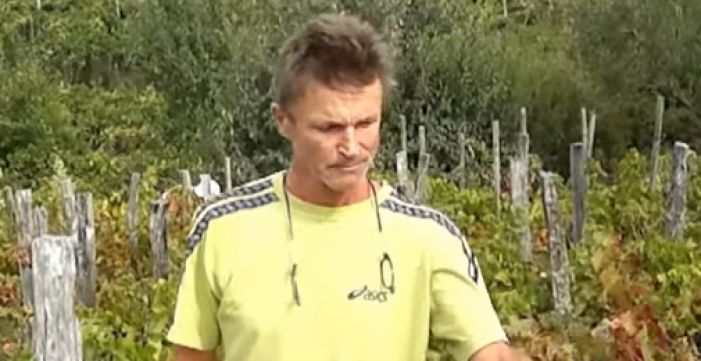
harvest report
08.09.2011
2011 Harvest Report from Francesco Maule
<p>The <glossary term="Harvest" title="521">harvest</glossary> has started off great, maybe a little earlier than normal. We have already harvested <glossary term="Merlot" title="650">Merlot</glossary> (see video) and the <glossary term="Garganega" title="482">Garganega</glossary> for the <glossary term="Recioto" title="846">Recioto</glossary> has already been placed on the hangers to dry.<br />
<br />
The vines suffered a little from the intense heat and dryness, but we are fully expecting a good year.</p>
<p><iframe allowfullscreen="" frameborder="0" height="345" src="https://www.youtube.com/embed/1r4O91CKKhk" width="560"></iframe></p>
<p> </p>
Article
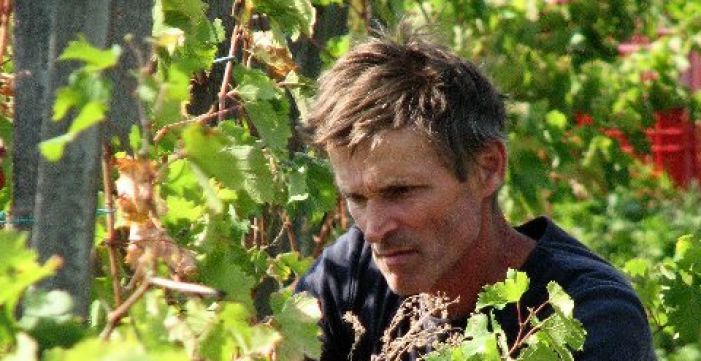
harvest report
12.07.2007
2007 Harvest Report from Angiolino Maule
<p><u><strong>July 12th:</strong></u></p>
<p>I have finished the <glossary term="Plowing" title="810">plowing</glossary> and the <glossary title="507">thinning of grape bunches</glossary> (where it needed to be done). For the leaves near the grapes, we’ll wait until it cools at the end of August which seems will be early this year. It has not rained since the beginning of June and it is very hot. After 30 days of this hot wind and <glossary term="Drought" title="1167">drought</glossary> the vines have had enough. The plants have shut down and I am quite worried because this is an important moment for the vine. We need a bit of water or a change of temperature so the plants can start working again. I hope it changes; I fear another year like 2003.<br />
<br />
<u><strong>August 22nd:</strong></u></p>
<p>After a summer not as hot (as expected) but dry we had a <glossary title="1136">hailstorm</glossary> that hit the highest hill. They were small but violent <span class="zalup"><span><glossary title="1136">hailstones</glossary><span>.</span></span></span> We quickly did a <glossary title="328">treatment</glossary> with magnesium silicate and already after a few days, the plants are healing themselves and, happy to say, so are we.<br />
<br />
<u><strong>August 30th:</strong></u></p>
<p>Five minutes of big <glossary title="1136">hailstones</glossary> that destroyed 70% of the production in the highest hills again (Talbane, Faldeo e Monte di Mezzo). This time we quickly did a <glossary term="Harvest" title="521">harvest</glossary> of the <span class="zalup"><span> <glossary title="1136">hail</glossary><span>-</span></span></span>hit grapes in Monte di Mezzo and the fallen grapes. We managed to get 15<glossary title="524">hl</glossary> of <glossary term="Must" title="700">must</glossary> from 1.7<span class="zalup"><span><glossary title="523">ha</glossary><span>.</span></span></span><br />
<br />
<u><strong>September 3rd:</strong></u></p>
<p>In harvesting the grapes for the <span class="zalup"><span><glossary title="846">Recioto</glossary><span>,</span></span></span> we only managed to find a few quintali because the <glossary title="1136">hail</glossary> stole a lot of grapes that were irreplaceable. The choice of the grapes is accurate and attentive.<br />
<br />
<u><strong>September 8th:</strong></u></p>
<p>We are harvesting the <glossary term="Merlot" title="650">Merlot</glossary> and right after the Tocai Rosso (<glossary term="Grenache" title="508">Grenache</glossary>) and I am happy because the sugar <glossary title="324">concentrations</glossary> and <glossary title="639">maturation</glossary> are at optimal level. I am a little worried, however, about the <glossary title="441">fermentations</glossary> of these two reds. After 25 days of <glossary title="610">skin maceration</glossary> we are still finding 3-4 degrees of sugar in the <glossary title="441">fermenting</glossary> <span class="zalup"><span><glossary term="Must" title="700">musts</glossary><span>.</span></span></span><br />
<br />
<u><strong>September 12th:</strong></u></p>
<p>The days are staying the same with large swings in temperature between day and night. We have begun the <glossary title="521">harvest</glossary> of the "Sassaia". The grapes are becoming beautiful – very <glossary title="639">mature</glossary> with sugar levels I have never seen on <span class="zalup"><span><glossary title="482">Garganega</glossary><span>.</span></span></span> We managed to pull in very little of the "Pico" grapes because these were the vines hardest hit by the <span class="zalup"><span><glossary title="1136">hail</glossary><span>.</span></span></span> I hope for good <glossary title="441">fermentations</glossary> in the <span class="zalup"><span><glossary title="254">cellar</glossary><span>.</span></span></span></p>
Article
















